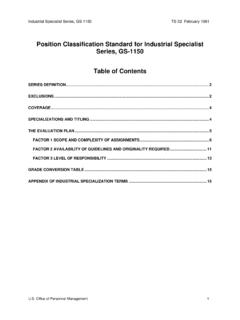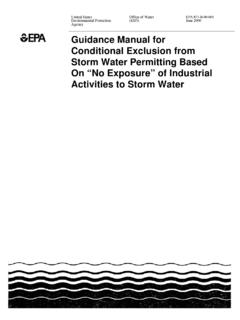Transcription of Commission Recommendation of 18 October 2011 on the ...
1 L 275/38 EN Official Journal of the european Union recommendations . Commission Recommendation . of 18 October 2011. on the definition of nanomaterial (Text with EEA relevance). (2011/696/EU). THE european Commission , regard to hazard or risk. This definition, based only on the size of a material, covers natural, incidental or manu . factured materials. Having regard to the Treaty on the Functioning of the european Union, and in particular Article 292 thereof, (5) The definition of the term nanomaterial' should be based on available scientific knowledge. Whereas: (6) Measuring size and size distributions in nanomaterials is (1) The Commission Communication of 7 June 2005 challenging in many cases and different measurement Nanosciences and nanotechnologies: An action plan for methods may not provide comparable results.
2 Europe 2005-2009' (1) defines a series of articulated and Harmonised measurement methods must be developed interconnected actions for the immediate implementation with a view to ensuring that the application of the defi . of a safe, integrated and responsible approach for nanos nition leads to consistent results across materials and ciences and nanotechnologies. over time. Until harmonised measurement methods are available, best available alternative methods should be applied. (2) The Commission , in line with the commitments made in the Action Plan, carefully reviewed relevant Union legis . lation with a view to determine the applicability of the (7) The european Commission Joint Research Centre existing regulations to the potential risks of nano Reference Report Considerations on a Definition of materials.
3 The result of the review was contained in the Nanomaterial for Regulatory purposes' (4) suggests that Commission Communication of 17 June 2008 Regu a definition of nanomaterials should address particulate latory aspects of nanomaterials' (2). The Communication nanomaterials, be broadly applicable in Union legislation concluded that the term nanomaterials' is not mentioned and be in line with other approaches worldwide. Size specifically in Union legislation but that existing legis should be the only defining property which necessitates lation in principle covers the potential health, safety a clear definition of the nanoscale limits. and environmental risks in relation to nanomaterials.
4 (3) The european Parliament in its resolution of 24 April (8) The Commission mandated the Scientific Committee on 2009 on regulatory aspects of nanomaterials (3) called, Emerging and Newly Identified Health Risks (SCENIHR). inter alia, for the introduction of a comprehensive to provide scientific input on elements to consider when science-based definition of nanomaterials in Union legis developing a definition of the term nanomaterial' for lation. regulatory purposes. The opinion Scientific basis for the definition of the term Nanomaterial ' was subject to a public consultation in 2010. In its opinion of 8 December 2010 (5), SCENIHR concluded that size is (4) The definition in this Recommendation should be used as universally applicable to nanomaterials and the most a reference for determining whether a material should be suitable measurand.
5 A defined size range would facilitate considered as a nanomaterial' for legislative and policy a uniform interpretation. The lower limit was proposed purposes in the Union. The definition of the term nano at 1 nm. An upper limit of 100 nm is commonly used material' in Union legislation should be based solely on by general consensus, but there is no scientific evidence the size of the constituent particles of a material, without to support the appropriateness of this value. The use of a (1) COM(2005) 243 final. (4) EUR 24403 EN, June 2010. (2) COM(2008) 366 final. (5) (3) P6_TA(2009) 0328. EN Official Journal of the european Union L 275/39. single upper limit value might be too limiting for the (12) Agglomerated or aggregated particles may exhibit the classification of nanomaterials and a differentiated same properties as the unbound particles.
6 Moreover, approach might be more appropriate. For regulatory there can be cases during the life-cycle of a nanomaterial purposes, the number size distribution should also be where the particles are released from the agglomerates or considered using the mean size and the standard aggregates. The definition in this Recommendation deviation of the size to refine the definition. The size should therefore also include particles in agglomerates distribution of a material should be presented as size or aggregates whenever the constituent particles are in distribution based on the number concentration ( the size range 1 nm-100 nm. the number of objects within a given size range divided by the number of objects in total) and not on the mass fraction of nanoscale particles in the nano.
7 Material as a small mass fraction may contain the largest number of particles. SCENIHR identified certain (13) At present it is possible to measure the specific surface specific cases where the application of the definition can area by volume for dry solid materials or powders with be facilitated by using the volume specific surface area as the nitrogen adsorption method ( BET-method'). In those proxy to determine if a material falls within the defined cases the specific surface area can be used as a proxy to nano size range. identify a potential nanomaterial. New scientific knowledge may expand the possibility to use this and other methods to other types of materials in the future.
8 There can be a discrepancy between the measurement of the specific surface area and the number size distribution (9) The International Organisation for Standardisation from one material to another. Therefore it should be defines the term nanomaterial' as material with any specified that results for number size distribution external dimensions in the nanoscale or having internal should prevail and it should not be possible to use the structure or surface structure in the nanoscale'. The term specific surface area to demonstrate that a material is not nanoscale' is defined as size range from approximately a nanomaterial. 1 nm to 100 nm (1). (10) The number size distribution should cover for the fact (14) Technological development and scientific progress that nanomaterials most typically consist of many continue with great speed.
9 The definition including particles present in different sizes in a particular descriptors should therefore be subject to a review by distribution. Without specifying the number size December 2014 to ensure that it corresponds to the distribution, it would be difficult to determine if a needs. In particular, the review should assess whether specific material complies with the definition where the number size distribution threshold of 50 % should some particles are below 100 nm while others are not. be increased or decreased and whether to include This approach is in line with the opinion of SCENIHR materials with internal structure or surface structure in that the particle distribution of a material should be the nanoscale such as complex nano-component nano.
10 Presented as the distribution based on the number materials including nano-porous and nano-composite concentration ( the particle number). materials that are used in some sectors. (11) There is no unequivocal scientific basis to suggest a specific value for the size distribution below which (15) Guidance and standardised measurement methods as well materials containing particles in the size range 1 nm- as knowledge about typical concentrations of nanopar . 100 nm are not expected to exhibit properties specific ticles in representative sets of materials should be to nanomaterials. The scientific advice was to use a stat developed where feasible and reliable to facilitate the istical approach based on standard deviation with a application of the definition in a specific legislative threshold value of 0,15 %.













